Ornaments in English Gardens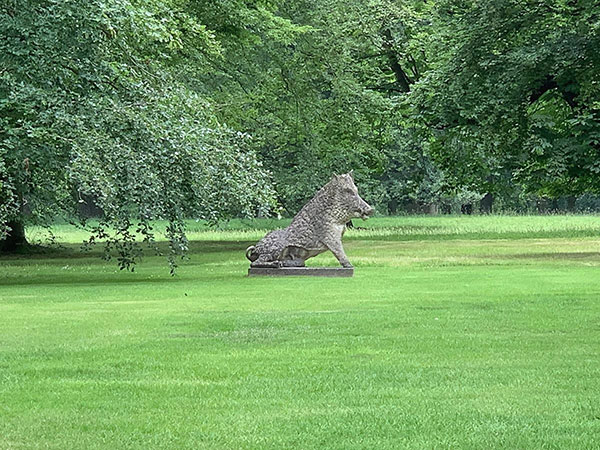
By Barbara Israel
Needless to say, when I visit English gardens, I take particular note of what and who have been chosen to populate the gardens. This summer I was treated to a number of such properties with some truly extraordinary statues. (Photo: The Uffizi Boar, Il Porcellino, in the landscape at Cottesbrooke Hall greeted us as we arrived.)
One of the finest gardens that I visited was at Cottesbrooke Hall in Northamptonshire. The house is primarily known for its exceptional Sporting Art, known as the Woolavington Collection that was assembled by the current owner’s grandfather. However, the property is also distinguished by an outstanding landscape embodying a great many rare and wonderful statues. The credit for the success of the gardens is attributed more to Lady Macdonald-Buchanan, whose family acquired the property in 1937, than to the landscape architects who have worked on it over the years.
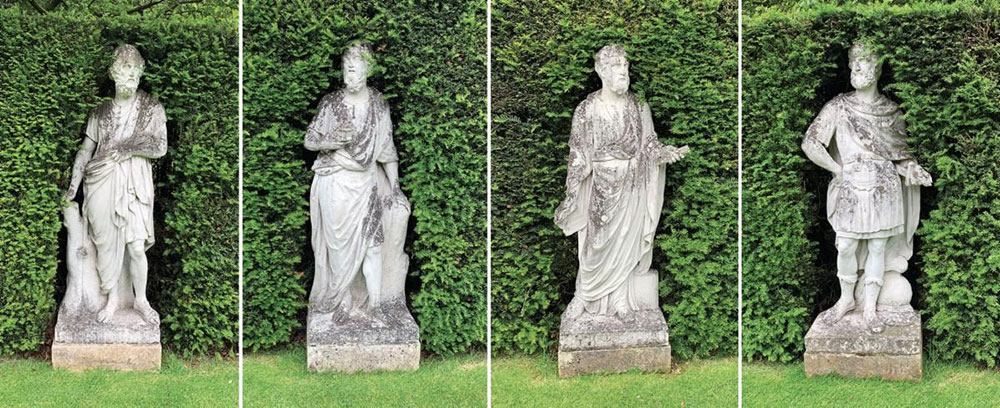
The Cottesbrooke statuary represents the absolute best that the English market has to offer. Along the “Statue Walk” I was stunned to hear that the four Portland Stone “Greek Worthies” tucked into niches in the hedges were the 1737 work of the one and only Peter Scheemakers (1691-1781, Flemish, active in England). I certainly recognized his name knowing him as an early 18th-century British sculptor but never expected to see his work during a casual stroll! I found out that this noteworthy quartet had been originally in the “Temple of Ancient Virtue” at Stowe House in Buckinghamshire. John Davis in his book on English ornament notes that these represent (left to right) Homer, the first and greatest poet, Socrates the greatest philosopher, Lycurgus the greatest law giver, and Epaminondas the finest general.
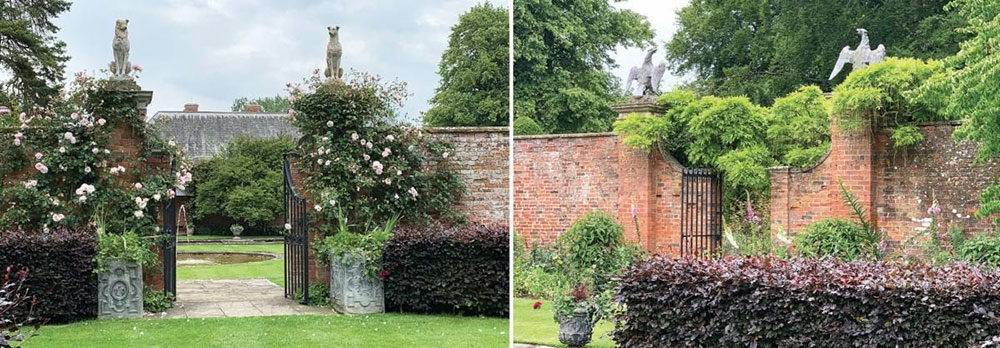
The extensive gardens at Cottesbrooke are mostly separated into “rooms” enclosed on the sides by brick or hedge walls. The gateposts at the two openings to the Pool Garden provided spots for animal statues, a refined pair of lead eagles and a pair of seated dogs. (Photos: Roses framing the entrance with a pair of hounds on alert; lead eagles with their wings outspread)
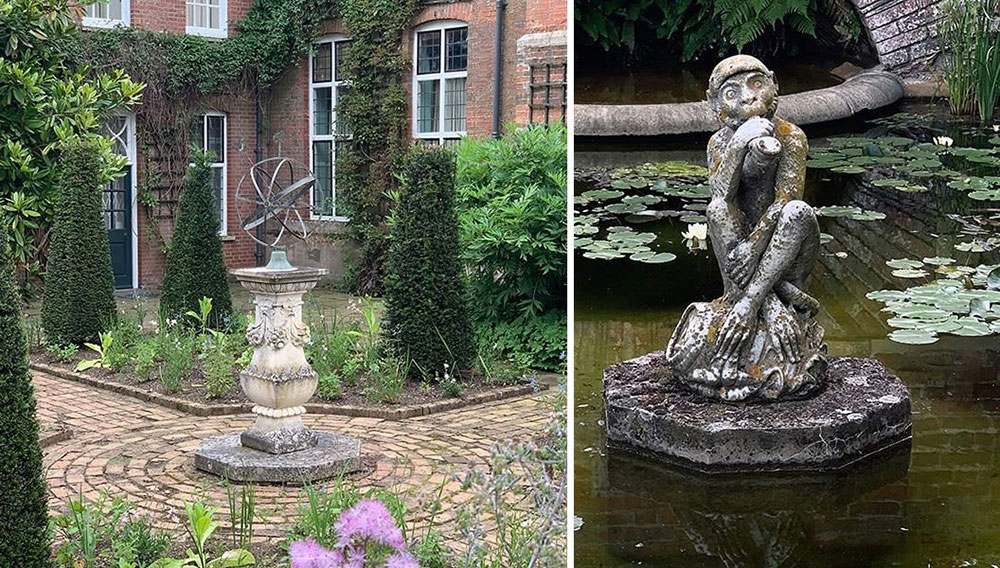
The Dutch Garden came next with symmetrical beds and intersecting brickwork paths and in the center a bronze armillary sphere (near right) on a spectacular stone base. Annuals and perennials fill the flower beds in a design inspired by a local designer, Angel Collins.
The aptly named Monkey Pool Garden has a rectangular formal pool of waterlilies that faces you as you enter. In the center is my very favorite of the day, a lead monkey fountain head (above) that is endearing to say the least. The plantings are all white in diminutive beds.
After all the intimate small gardens we were unexpectedly treated to an expansive vista (below) set into the open forecourt formed by the wings of the house. Our guides were the owners Alastair and Sheran Macdonald-Buchanan who knew every corner of the house and grounds, he having grown up there. As we tried to take in the vastness of the view, he pointed out that it had been designed to frame the tiny spire of the Brixworth Church that you can see way off in the distance.
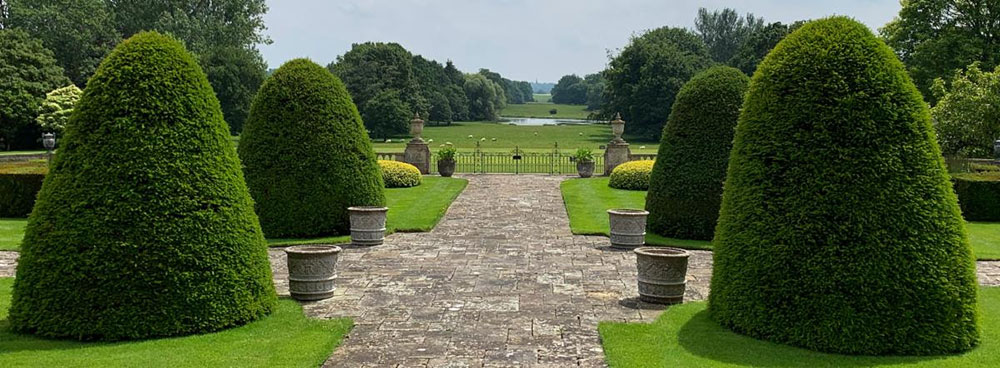
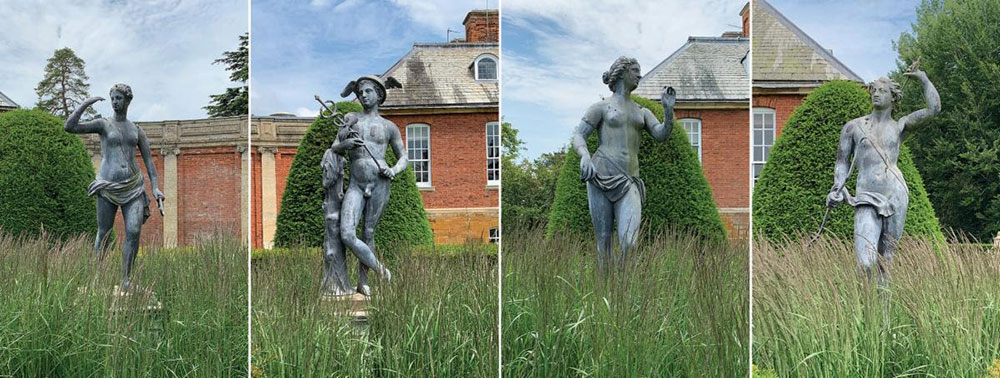
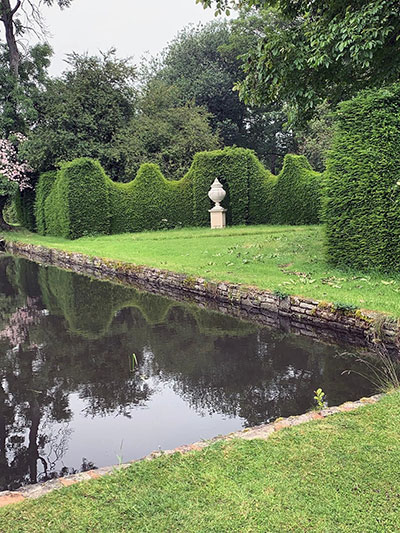 I was so taken with the scene in front of me that I was slow to register the four lead statues (above) that were each centered in separate quadrants bounded by tightly pruned yew. The original designer of this formal space was Sir Geoffrey Jellicoe (1900-1996) when in the 1930s he reversed the location of the entrance drive and created this masterpiece. The 1702 Queen Anne house overlooks this perfectly symmetrical garden. The statue of Diana the Huntress, likely an 18th-century piece, stands amidst long grasses giving the impression of her literally being in the woodland. Nearby Mercury stands with his legs crossed leaning on a stump appearing to wait patiently for some action. A similar 18th-century lead representation of Venus stands on the right seeming to motion to Apollo who is across from her. A beautifully languid Apollo, another of the same rare set, stands with his arm raised to bring an arrow forward in anticipation of a shot. I didn’t remember at that point that he was the God of the Bow and is often depicted as such. (Photos: left to right: Diana, Mercury, Venus, and Apollo)
I was so taken with the scene in front of me that I was slow to register the four lead statues (above) that were each centered in separate quadrants bounded by tightly pruned yew. The original designer of this formal space was Sir Geoffrey Jellicoe (1900-1996) when in the 1930s he reversed the location of the entrance drive and created this masterpiece. The 1702 Queen Anne house overlooks this perfectly symmetrical garden. The statue of Diana the Huntress, likely an 18th-century piece, stands amidst long grasses giving the impression of her literally being in the woodland. Nearby Mercury stands with his legs crossed leaning on a stump appearing to wait patiently for some action. A similar 18th-century lead representation of Venus stands on the right seeming to motion to Apollo who is across from her. A beautifully languid Apollo, another of the same rare set, stands with his arm raised to bring an arrow forward in anticipation of a shot. I didn’t remember at that point that he was the God of the Bow and is often depicted as such. (Photos: left to right: Diana, Mercury, Venus, and Apollo)
Another day I visited the “Court of Noke” in Herefordshire. It is the home of the renowned English designer Edward Bulmer and Emma, his wife. Edward has developed a line of paints called Edward Bulmer Natural Paint, (www.edwardbulmerpaint.co.uk). On hearing about it I became convinced that it is the paint of the future as it is non-toxic, chemical free and eco-friendly and comes in glorious colors. We were invited for lunch and had tea afterward in their walled garden. Of course, I wandered around enough to appreciate Edward’s eclectic choices in ornament. They seemed respectful but untrammeled by English tradition thus experimenting with various forms and colors. The property has a number of canals and he used one view to highlight a lidded urn on stand set off by an eccentrically trimmed hedge and its reflection in the water. (Photo: Edward’s Urn)
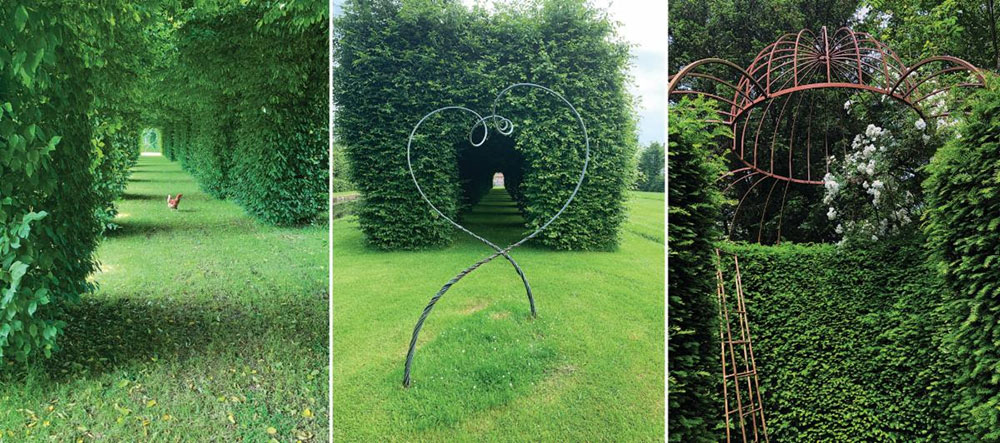
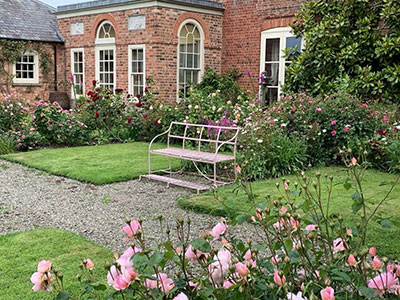 A long tunnel of hornbeam borders the canal on the other side. A friendly hen (left photo) accompanied me all the way to the end where I found a contemporary art work of twisted metal perfectly centered in the last arch (center photo). I always envy these thick corridors of plantings that English gardens display to poor unsuspecting visitors who have little clue and inadequate climate to grow them!
A long tunnel of hornbeam borders the canal on the other side. A friendly hen (left photo) accompanied me all the way to the end where I found a contemporary art work of twisted metal perfectly centered in the last arch (center photo). I always envy these thick corridors of plantings that English gardens display to poor unsuspecting visitors who have little clue and inadequate climate to grow them!
In and out among all the creative aspects of the garden I came upon a wrought-iron cupola (right) that had been placed on top of a tall circular hedge with climbing roses intertwined with it. I decided it was an open-air folly of sorts that added a further architectural impression to the garden.
Their rose garden (above) was resplendent in pink including even the games seat tucked in between the patches of lawn. I assume that the pink paint is an example of one of his splendid colors. It’s an unusual choice but works perfectly in this setting.
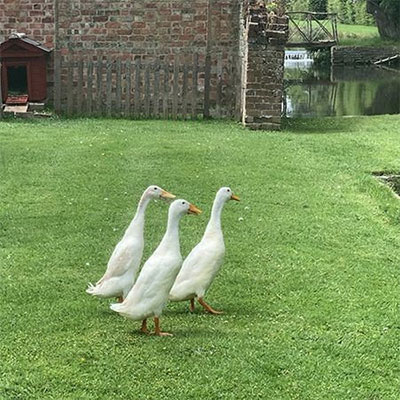 The best treat that greeted me on our way out were the three Indian Runner Ducks (right) that are particular favorites of homeowners with ponds. Their little feet move rapidly as they carry their little bodies upright and still with positively comedic flair.
The best treat that greeted me on our way out were the three Indian Runner Ducks (right) that are particular favorites of homeowners with ponds. Their little feet move rapidly as they carry their little bodies upright and still with positively comedic flair.
Another day I was in for a big surprise. My definition of garden ornaments most certainly includes strange buildings, often follies, but little did I know that it would include one of the greatest small buildings that I’d ever seen. Badminton House, the principal seat of the Dukes of Beaufort for generations, is in Gloucestershire and boasts an enormous piece of property that encompasses a deer park. In the midst of a field that seemed to promise nothing but sheep we were escorted out with assurances galore that it would be worth the trek in spite of scant evidence of an objective. Finally, over a bit of a knoll we were confronted with an extraordinary little dwelling.
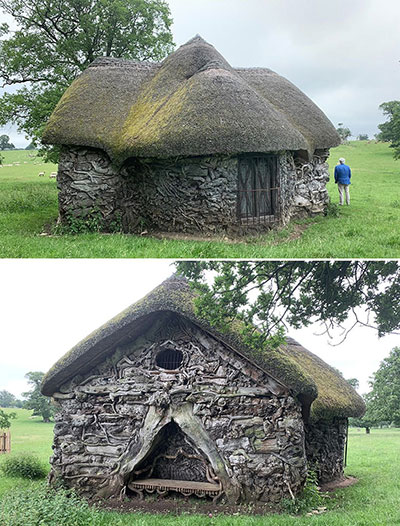 Known as The Hermit’s Cell (right) this little building is a hermitage, part of an unusual practice in English landscape gardens of the 18th and 19th century that encouraged land owners to provide a space for a hermit to live. The hermit’s “job” was fairly undefined but his presence connoted the Arcadian lifestyle and provided a novelty guest who might be introduced to visitors. This custom was a contrivance of the landscape tradition that large landowners accepted by installing such structures.
Known as The Hermit’s Cell (right) this little building is a hermitage, part of an unusual practice in English landscape gardens of the 18th and 19th century that encouraged land owners to provide a space for a hermit to live. The hermit’s “job” was fairly undefined but his presence connoted the Arcadian lifestyle and provided a novelty guest who might be introduced to visitors. This custom was a contrivance of the landscape tradition that large landowners accepted by installing such structures.
This particular hermitage is actually a “listed” building meaning it is protected and preserved. It was created by Thomas Wright of Durham (1711-1786) around 1750. It is one of his finest structures made with a thatched roof, four knotty tree trunks at the corners, and the walls inset with branches and roots. Wright was said by Headley & Meulenkamp in Follies, Grottoes and Garden Buildings to have been at the height of his career when he built this. It is most extraordinary that it be extant after 250 years alone in the middle of the deer park.
Each side of the building was different and I especially favored the side with the rustic bench (bottom photo). Protected by the inverted fork of a tree, it has an inscription that reads in nail-heads, “Here Loungers Loiter—Here The Weary Rest”.
What an experience to see such a creation and a credit to the owners of Badminton (yes, the game was named after this house) for having preserved it so well for so many years. I always find English houses and gardens full of discoveries but this little hermitage really stole my heart!
The Allure of Venetian Wellheads
By Eva Schwartz
A recent acquisition of two Venetian wellheads (below) from the Villa am Meer estate in Longboat Key, FL gave us reason to reacquaint ourselves with the story of wellheads and how they came to be treasured components of the American garden. Of all the garden ornaments we collect and admire, the Venetian wellhead seems most imbued with both historic importance and romantic spirit. It tells a story like no other, and adds an almost regal weight to a garden. Wellheads first played a vital role in Venetian culture, but then took on an equally important second life–this time as coveted art objects collected (i.e. pillaged) by dealers, connoisseurs, and travelers on the Grand Tour.
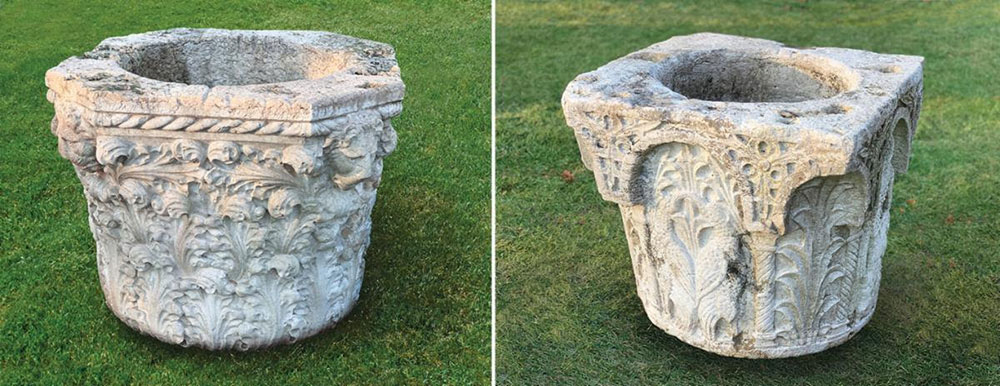
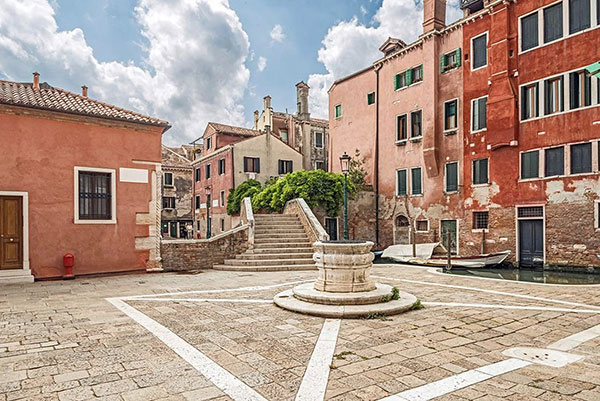 The proliferation of wellheads in Venice arose, of course, out of necessity. The Venetian historian and diarist, Marino Sanudo (1466-1536) wrote of the irony that “Venezia è in aqua ma non ha aqua”— i.e. Venice is in water, but doesn’t have water. As a saltwater-locked island city, Venice faced the challenge of supplying fresh water to its citizens. For centuries, this monumental task was accomplished through the use of ingeniously engineered wells. Unlike traditional wells that tapped into ground water, Venice’s wells filtered, collected, and stored rainwater. When it rained, water flowed into drains that were located around a central cistern that was capped with a lidded wellhead. The drains were placed at some distance from the wellhead and the pavement was gently sloped to encourage water to flow into the drains. (One drain is visible in the lower right corner of the above photo.) The water ran into a large underground chamber and was filtered through ever-finer pebbles and sand. Eventually this filtered water seeped into the central cistern where it was stored for use. (Photo: Didier Descouens [CC BY-SA (https://creativecommons.org/licenses/by-sa/4.0)])
The proliferation of wellheads in Venice arose, of course, out of necessity. The Venetian historian and diarist, Marino Sanudo (1466-1536) wrote of the irony that “Venezia è in aqua ma non ha aqua”— i.e. Venice is in water, but doesn’t have water. As a saltwater-locked island city, Venice faced the challenge of supplying fresh water to its citizens. For centuries, this monumental task was accomplished through the use of ingeniously engineered wells. Unlike traditional wells that tapped into ground water, Venice’s wells filtered, collected, and stored rainwater. When it rained, water flowed into drains that were located around a central cistern that was capped with a lidded wellhead. The drains were placed at some distance from the wellhead and the pavement was gently sloped to encourage water to flow into the drains. (One drain is visible in the lower right corner of the above photo.) The water ran into a large underground chamber and was filtered through ever-finer pebbles and sand. Eventually this filtered water seeped into the central cistern where it was stored for use. (Photo: Didier Descouens [CC BY-SA (https://creativecommons.org/licenses/by-sa/4.0)])
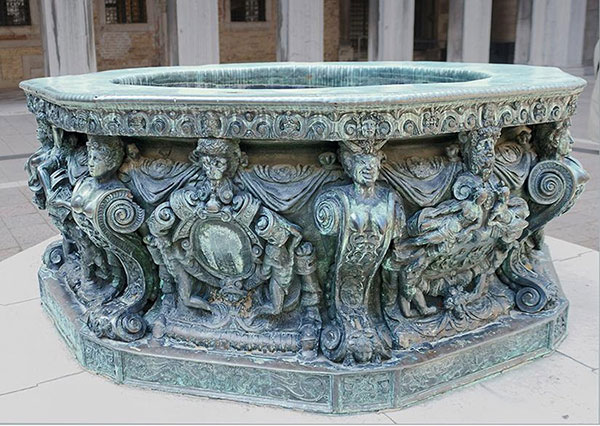 In 1300, there were about 100 wells in Venice. In 1322, the Great Council (the political body of the Republic of Venice) voted for the construction of 50 additional wells, followed by 30 more in 1424. By 1797, when the Venetian Republic fell, there were more than 6,000 private and public wells in the city. Although some Venetian wellheads were carved of pinkish Rosso Verona marble, and some were cast in bronze (including the two large examples adjacent to the Doge’s Palace, one is depicted at right), the majority were carved of Istrian stone, and for good reason. Istrian stone, a dense, non-porous variety of limestone that actually wears more like marble, was both extremely durable, and plentiful in the region. Primarily found in Istria (formerly the Venetian Republic, now Croatia), blocks of Istrian stone were shipped across the Adriatic Sea on barges bound for Venice. [Note: Very early, pre-13th century examples were carved of Greek marble or Aurisina limestone—before Istrian stone became the material of choice.] (Photo: Didier Descouens [CC BY-SA (https://creativecommons.org/licenses/by-sa/4.0)])
In 1300, there were about 100 wells in Venice. In 1322, the Great Council (the political body of the Republic of Venice) voted for the construction of 50 additional wells, followed by 30 more in 1424. By 1797, when the Venetian Republic fell, there were more than 6,000 private and public wells in the city. Although some Venetian wellheads were carved of pinkish Rosso Verona marble, and some were cast in bronze (including the two large examples adjacent to the Doge’s Palace, one is depicted at right), the majority were carved of Istrian stone, and for good reason. Istrian stone, a dense, non-porous variety of limestone that actually wears more like marble, was both extremely durable, and plentiful in the region. Primarily found in Istria (formerly the Venetian Republic, now Croatia), blocks of Istrian stone were shipped across the Adriatic Sea on barges bound for Venice. [Note: Very early, pre-13th century examples were carved of Greek marble or Aurisina limestone—before Istrian stone became the material of choice.] (Photo: Didier Descouens [CC BY-SA (https://creativecommons.org/licenses/by-sa/4.0)])

The earliest Venetian wellheads were old column capitals, hollowed out. These were followed in the early Middle Ages by wellheads that were densely carved with mythological animalia and vegetal motifs borrowed from the Romanesque period (left). In the 14th century, a form arose that would become the standard for a couple of centuries–a tapered cylindrical body with quadrangular top element and suspended arches. Many of the wellheads that remain in Venice–some of them quite utilitarian-looking–conform to this particular type (center). Still others (right), dating to the 15th and 16th centuries, are profusely carved in high relief with classical elements including portrait busts, lion masks, floral and fruited festoons, and acanthus leaves. (Photos, left to right, courtesy: Metropolitan Museum of Art [CC0]; Eugenio Hanson OFS [CC BY-SA (https://creativecommons.org/licenses/by-sa/4.0)]; Nino Barbieri [CC BY-SA (https://creativecommons.org/licenses/by-sa/2.5)])
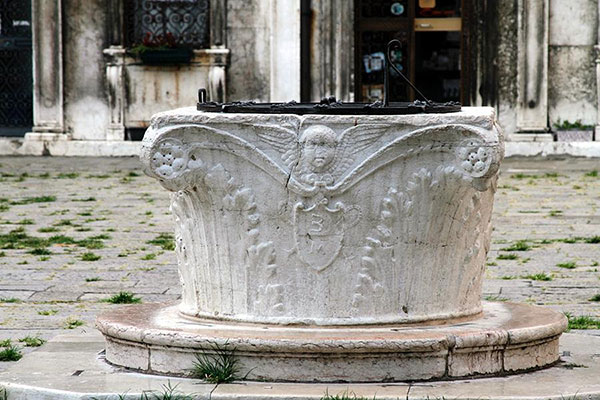 As wellheads (both public and private) were paid for by wealthy Venetian families, they often bore the name and/or crest of the donors (right). The wellheads were a point of pride for donor families and a reminder to fellow Venetians of their power and influence. So precious was the water in these wells that wellheads were kept locked via large metal and/or wooden lids that were opened only twice a day by a parish priest entrusted with the task. For centuries, water resources were carefully protected in this way. (Photo: © José Luiz Bernardes Ribeiro, via Wikimedia Commons)
As wellheads (both public and private) were paid for by wealthy Venetian families, they often bore the name and/or crest of the donors (right). The wellheads were a point of pride for donor families and a reminder to fellow Venetians of their power and influence. So precious was the water in these wells that wellheads were kept locked via large metal and/or wooden lids that were opened only twice a day by a parish priest entrusted with the task. For centuries, water resources were carefully protected in this way. (Photo: © José Luiz Bernardes Ribeiro, via Wikimedia Commons)
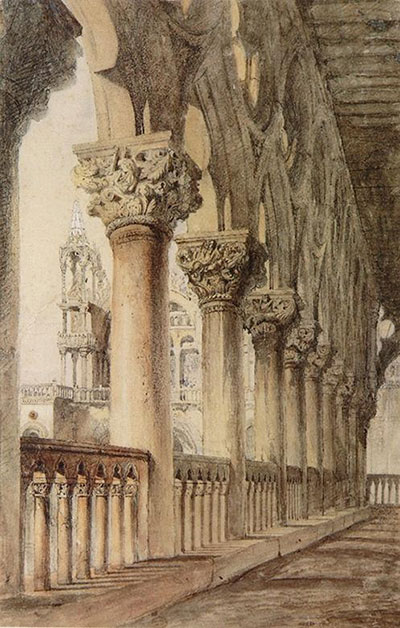 With the construction of the first aqueduct in 1884, however, wells were filled in and no longer used. Consequently, thousands of wellheads became ornamental relics. This change of circumstance compounded an already-prevalent situation: the selling-off of Venice’s wellheads. According to Hungarian art historian Anna Tüskés, Venice had begun selling its wellheads to museums and art collectors as early as the 1840s, first to buyers throughout the Austro-Hungarian Empire, and later to clients in England and America. Many of the private ones were sold to boost the dwindling financial resources of Venice’s noble families. The fervor to sell these pieces, both private and public, was intensified by the publication of guidebooks and memoirs written by historians and critics on the Italian Grand Tour.
With the construction of the first aqueduct in 1884, however, wells were filled in and no longer used. Consequently, thousands of wellheads became ornamental relics. This change of circumstance compounded an already-prevalent situation: the selling-off of Venice’s wellheads. According to Hungarian art historian Anna Tüskés, Venice had begun selling its wellheads to museums and art collectors as early as the 1840s, first to buyers throughout the Austro-Hungarian Empire, and later to clients in England and America. Many of the private ones were sold to boost the dwindling financial resources of Venice’s noble families. The fervor to sell these pieces, both private and public, was intensified by the publication of guidebooks and memoirs written by historians and critics on the Italian Grand Tour.
One of these was the English critic and intellectual, John Ruskin (1819-1900), who published the notable treatise, The Stones of Venice, between 1851 and 1853. An architectural survey-turned social reform manifesto, The Stones of Venice relates in its many descriptive passages various charming aspects of Venetian life, including mentions of wellheads. Other English writers like Augustus Hare (1834-1903) contributed to the cause with travel guides focused on Venice and other European locales. We know from his autobiography, The Story of My Life (1896), that Hare was an admirer of wellheads. He even bought two for himself and had them installed in his Renaissance-style garden in Sussex. (Illustration: John Ruskin [Public domain])
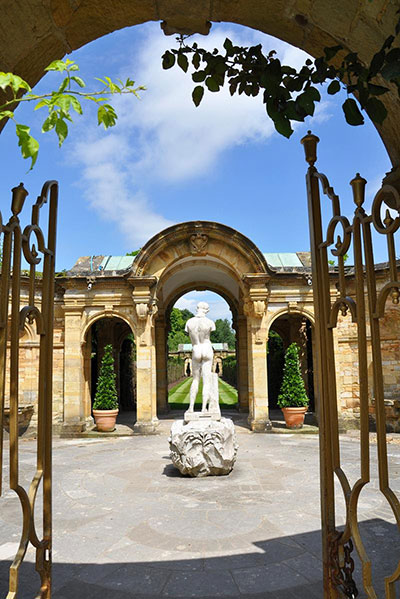 Some of the finest examples of Venetian wellheads in English gardens can be found at Hever Castle in Kent. The Tudor-period castle has a storied history, having been the childhood home of Anne Boleyn (ca. 1501-1536), King Henry VIII’s second wife. Most of the gardens, including the spectacular Italian gardens (right), were built much later by the American philanthropist, William Waldorf Astor (1848-1919). Astor moved to England with his wife and children in the early 1890s and in 1903 purchased Hever Castle, which had by then fallen into disrepair. The house was meticulously restored and expanded and the exceptional gardens, outfitted with the finest ornament, were the crowning achievement. (Photo: Christoph Matthias Siebenborn [CC BY (https://creativecommons.org/licenses/by/3.0)])
Some of the finest examples of Venetian wellheads in English gardens can be found at Hever Castle in Kent. The Tudor-period castle has a storied history, having been the childhood home of Anne Boleyn (ca. 1501-1536), King Henry VIII’s second wife. Most of the gardens, including the spectacular Italian gardens (right), were built much later by the American philanthropist, William Waldorf Astor (1848-1919). Astor moved to England with his wife and children in the early 1890s and in 1903 purchased Hever Castle, which had by then fallen into disrepair. The house was meticulously restored and expanded and the exceptional gardens, outfitted with the finest ornament, were the crowning achievement. (Photo: Christoph Matthias Siebenborn [CC BY (https://creativecommons.org/licenses/by/3.0)])
William Waldorf Astor was a passionate art collector, his interest ignited while living in Rome and serving as President Chester Arthur’s Italian Minister from 1882 to 1885. The Italian Gardens at Hever Castle are ornamented with Roman sarcophagi, amphorae from Pompeii, statues, water features, and an outstanding collection of 14th-16th century Venetian wellheads. The revival of the formal, Italianate garden, so strikingly different from the naturalistic park spaces that had been fashionable for more than a century, was spurred by the numbers of travelers to Italy who wrote about their experiences, took sojourns there to study, and brought home artifacts as mementos. Wellheads, symbolic of both Venetian engineering and artistry, became some of the most treasured souvenirs. Pictured below are two of the wellheads at Hever Castle, showing an evolution of style from the 15th to the 16th century. The robust square-form wellhead with luxuriant corner acanthus leaves and rosettes was typical of the 15th century. Its direct antecedent was the ancient Corinthian capital, adapted for use as a wellhead in the early Medieval era. Another Hever example, this one from the Renaissance period (likely dating to the 16th century), is less reliant on architectural precedent and more overtly inventive. It fully embraces classical design elements with its use of lion masks, acanthus leaves and cartouches carved in deep relief. (Photos: Barbara Israel)
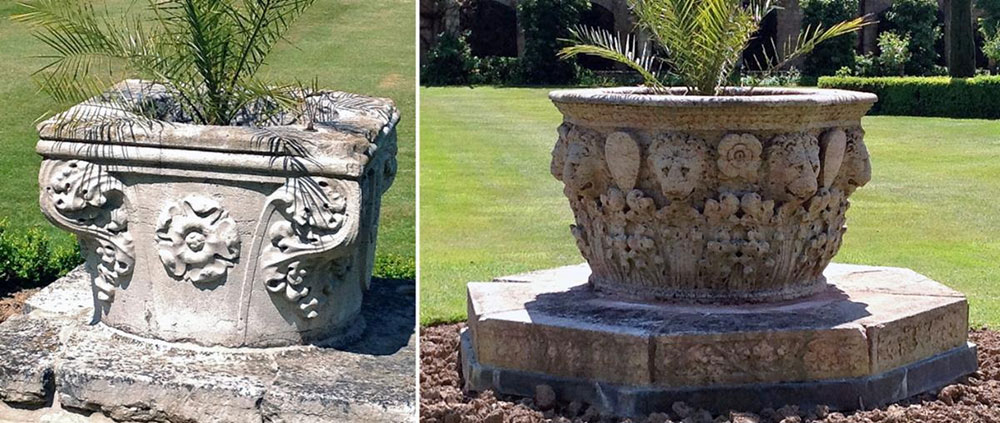
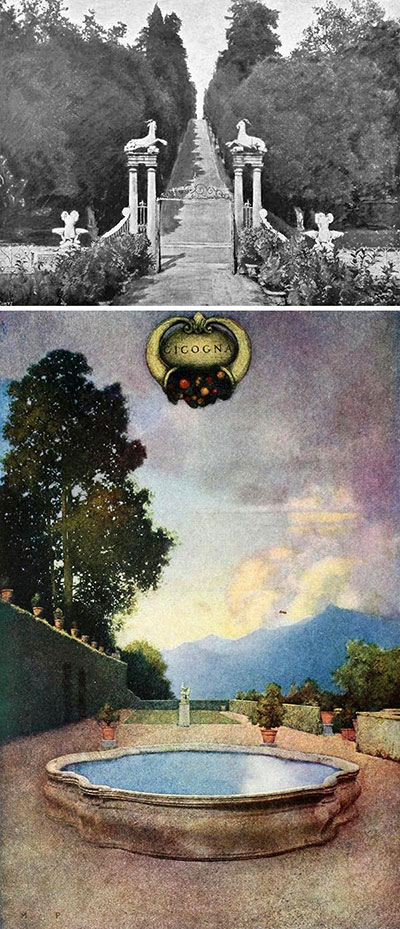 At the same time William Waldorf Astor was living in Rome, numerous other Americans–mostly affluent students, but also artists and architects–traveled to Europe to partake in the Grand Tour. This rite of passage afforded those who undertook it a certain cachet–one that came from having studied and absorbed the great lessons of European history, art, and culture. In the United States in the late 19th century, despite efforts by the National Sculpture Society and similar organizations to develop and promote a distinctly American brand of art, there was still a conspicuous dependence on European standards and a belief in the superiority of European training. Charles Platt (1861-1933), an American artist-turned architect and landscape architect, traveled to Italy with his brother in 1892. Visits to several important Renaissance gardens, including the Boboli Gardens (top illustration) and the Villa d’Este, had a transformative effect on the young artist. Platt’s writings on the experience–appearing first in two articles in Harper’s New Monthly Magazine in 1893– resulted in the 1894 publication of the seminal book, Italian Gardens. This book, hugely important in the American design world, describes in detail the characteristics of Italian Renaissance gardens with an eye toward inspiring practitioners back home. In his concluding remarks, Platt notes that his purpose was to “show some of the most salient of the existing features of the formal garden as they may be seen to-day in Italy…It is hoped that this work may be of value towards a more thorough understanding and appreciation of the reasons which led to a formal treatment of the garden; and as there is a great similarity in the character of the landscape in many parts of our country with that of Italy, that it might lead to a revival of the same method”. (Top illustration: Charles A. Platt, 1893 [Public domain])
At the same time William Waldorf Astor was living in Rome, numerous other Americans–mostly affluent students, but also artists and architects–traveled to Europe to partake in the Grand Tour. This rite of passage afforded those who undertook it a certain cachet–one that came from having studied and absorbed the great lessons of European history, art, and culture. In the United States in the late 19th century, despite efforts by the National Sculpture Society and similar organizations to develop and promote a distinctly American brand of art, there was still a conspicuous dependence on European standards and a belief in the superiority of European training. Charles Platt (1861-1933), an American artist-turned architect and landscape architect, traveled to Italy with his brother in 1892. Visits to several important Renaissance gardens, including the Boboli Gardens (top illustration) and the Villa d’Este, had a transformative effect on the young artist. Platt’s writings on the experience–appearing first in two articles in Harper’s New Monthly Magazine in 1893– resulted in the 1894 publication of the seminal book, Italian Gardens. This book, hugely important in the American design world, describes in detail the characteristics of Italian Renaissance gardens with an eye toward inspiring practitioners back home. In his concluding remarks, Platt notes that his purpose was to “show some of the most salient of the existing features of the formal garden as they may be seen to-day in Italy…It is hoped that this work may be of value towards a more thorough understanding and appreciation of the reasons which led to a formal treatment of the garden; and as there is a great similarity in the character of the landscape in many parts of our country with that of Italy, that it might lead to a revival of the same method”. (Top illustration: Charles A. Platt, 1893 [Public domain])
Platt’s contemporary, the American novelist and tastemaker, Edith Wharton (1862-1937), added her own voice to the collective endorsement of Italian garden design with the publication Italian Villas and Their Gardens in 1904. This essential work, even more widely read than Platt’s, was a singular achievement due to Wharton’s easy grasp of the European classical tradition and her ability to deftly place each garden and villa within the scope of the classical oeuvre. Beyond this, Wharton had a gift for setting a scene, and for conveying the feeling that these gardens summoned. For her, the classical Italian garden exemplified the harmony that could exist between human beings and the natural world–and this book made American readers want to create a bit of that harmony for themselves. Complementing Wharton’s perceptive prose is a collection of romantic, idyllic illustrations (bottom illustration) provided by American artist, Maxfield Parrish (1870-1966). The effect of the whole is quite dazzling; it isn’t hard to understand why the book was so wildly influential.
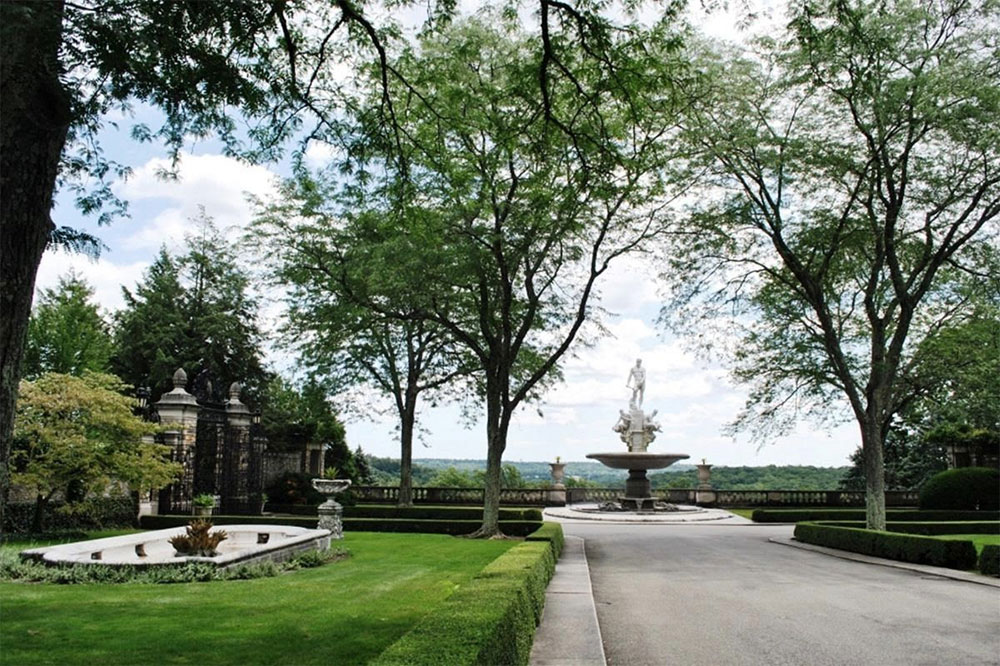
Indeed, the effect of Wharton’s book–and of Platt’s–was lasting. In a 1911 article for The American Architect titled “The Garden at Pocantico Hills”, architect William Welles Bosworth (1869-1966), who happened to be working at the time on the design and construction of John D. Rockefeller’s Kykuit estate (above), praises Italian gardens as the “origin of all subsequent garden tradition”. (Photo: Elisa.rolle [CC BY-SA (https://creativecommons.org/licenses/by-sa/4.0)])
In recounting the rise of the formal garden, Bosworth reminds us, rather derisively, of the naturalistic landscape style that started in England and flourished in America through the practices of Andrew Jackson Downing (1815-1852) and Frederick Law Olmsted (1822-1903):
Having no American gardens to follow, but rather, English influences, with the great preponderance of English literature to furnish the background of romance…it was naturally the English treatment of lawn and specimen trees, with now and then a pond and a rustic bridge and swan here and there, a statue or vase of cast iron painted white, standing in a bed of canna or castor bean that satisfied the hearts of our fathers. But there followed the faster crossing of the ocean and European travel, and people brought home miniature columns and triumphal arches from the Roman forum…Architects began to go to the École des Beaux-Arts, where they tell you in disdain that the best way to plan an English garden is to stick a few pins at random on the paper to represent trees, then crumple up a piece of twine and drop it over them for paths.
In order to outfit the new formal estate gardens, art dealers:
… began to import all sorts of so-called garden ornaments, presumably antique; well-heads became fashionable and quantities of these and drinking fountains…are now to be found mixed in with classic and English and French vases, benches and sun dials. These ornaments, since they perform the mission of focusing the eye at the given points, really set the keynote of style where they occur.
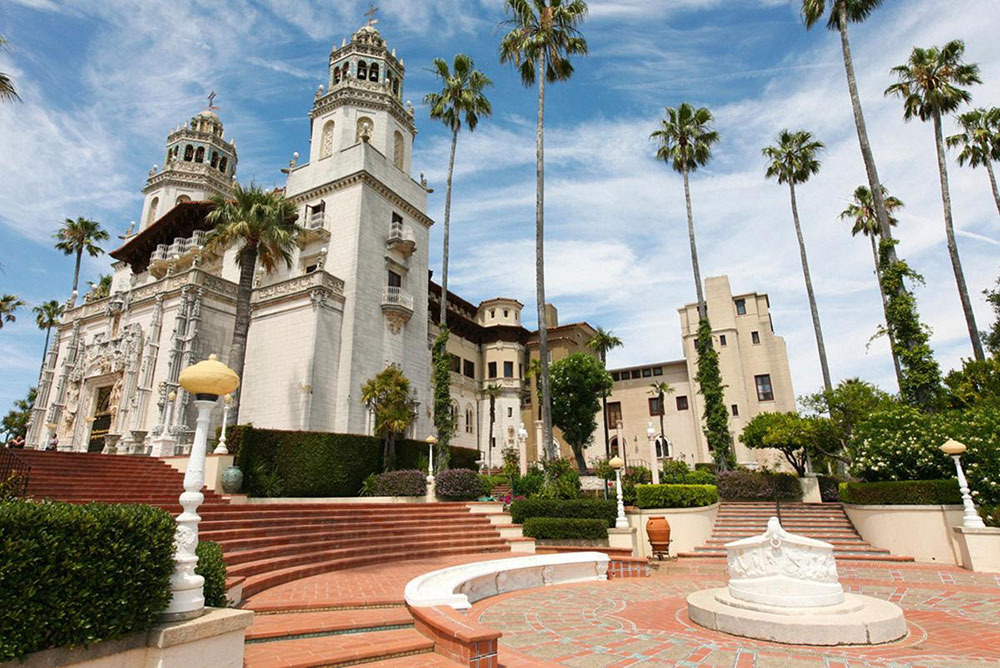 One of the art dealers responsible for importing large numbers of garden ornaments from Italy was Eugene Glaenzer, a Frenchman who operated primarily out of New York. Beginning in the 1890s, Glaenzer was the chief importer of art and antiques for Stanford White (1853-1906), principal of the world-renowned architectural firm McKim, Mead and White. Glaenzer also traded in fine art and paintings, selling masterworks to the Metropolitan Museum of Art and the Louvre. He was instrumental in acquiring Italian ornaments for exceptional estates throughout the United States, including Vizcaya, industrialist James Deering’s Miami home, and Hearst Castle, the California property of William Randolph Hearst (above). In 1903 he established a studio in New York City that he called his “jardin” where quantities of wellheads, oil jars, urns, columns, and benches were available for sale. There he capitalized on the enthusiasm for Renaissance style formal gardens, and all the accoutrements that went with them. (Photo: Proims [CC BY-SA (https://creativecommons.org/licenses/by-sa/3.0)])
One of the art dealers responsible for importing large numbers of garden ornaments from Italy was Eugene Glaenzer, a Frenchman who operated primarily out of New York. Beginning in the 1890s, Glaenzer was the chief importer of art and antiques for Stanford White (1853-1906), principal of the world-renowned architectural firm McKim, Mead and White. Glaenzer also traded in fine art and paintings, selling masterworks to the Metropolitan Museum of Art and the Louvre. He was instrumental in acquiring Italian ornaments for exceptional estates throughout the United States, including Vizcaya, industrialist James Deering’s Miami home, and Hearst Castle, the California property of William Randolph Hearst (above). In 1903 he established a studio in New York City that he called his “jardin” where quantities of wellheads, oil jars, urns, columns, and benches were available for sale. There he capitalized on the enthusiasm for Renaissance style formal gardens, and all the accoutrements that went with them. (Photo: Proims [CC BY-SA (https://creativecommons.org/licenses/by-sa/3.0)])
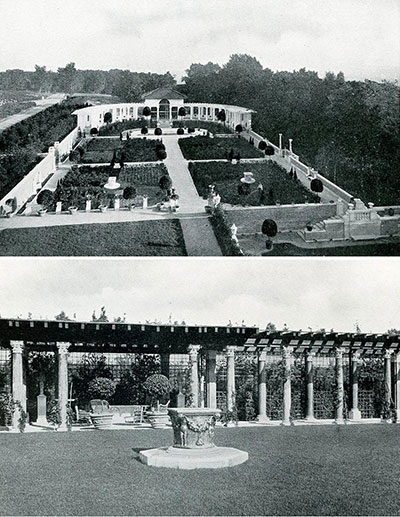 An admirer of Eugene Glaenzer was Samuel Swift, a sharp-witted, opinionated art critic who often wrote for House & Garden. Highlights from Glaenzer’s garden are featured in Swift’s article “Garden Marbles from Abroad”, which appeared in the August 1903 issue of House & Garden. Of particular note are the number of wellheads pictured, including one that was soon purchased by William Randolph Hearst for Hearst Castle (above photo, foreground). Swift observes that “old well-heads…are turned into palm jars, or filled with miscellaneous plants. The bowls of ancient fountains, detached from crumbling settings in Italy…begin life over again in the new world, under rich if not always judicious auspices, as receptacles for growing flowers or for swimming gold fish. Emigration is the order of the day in Italy”. Swift points out that the demand for Medieval and Renaissance wellheads far exceeded the supply–necessitating the production of old-style wellheads specifically made for the export market. These were made to mimic not only the style of the old pieces, but their aged/eroded look as well (even down to the rope grooves). Thus, dating Venetian wellheads can often be a very tricky business. At the time, Swift was worried that American buyers would utterly clean Italy out of its ancient holdings: “Every time an old Italian estate is to be broken up, American and English agents vie with Italian dealers in getting first news of it, and expeditions are made to remote country districts for the sake of picking up a fountain, a crumbling urn, a tree-tub or an old sarcophagus”.
An admirer of Eugene Glaenzer was Samuel Swift, a sharp-witted, opinionated art critic who often wrote for House & Garden. Highlights from Glaenzer’s garden are featured in Swift’s article “Garden Marbles from Abroad”, which appeared in the August 1903 issue of House & Garden. Of particular note are the number of wellheads pictured, including one that was soon purchased by William Randolph Hearst for Hearst Castle (above photo, foreground). Swift observes that “old well-heads…are turned into palm jars, or filled with miscellaneous plants. The bowls of ancient fountains, detached from crumbling settings in Italy…begin life over again in the new world, under rich if not always judicious auspices, as receptacles for growing flowers or for swimming gold fish. Emigration is the order of the day in Italy”. Swift points out that the demand for Medieval and Renaissance wellheads far exceeded the supply–necessitating the production of old-style wellheads specifically made for the export market. These were made to mimic not only the style of the old pieces, but their aged/eroded look as well (even down to the rope grooves). Thus, dating Venetian wellheads can often be a very tricky business. At the time, Swift was worried that American buyers would utterly clean Italy out of its ancient holdings: “Every time an old Italian estate is to be broken up, American and English agents vie with Italian dealers in getting first news of it, and expeditions are made to remote country districts for the sake of picking up a fountain, a crumbling urn, a tree-tub or an old sarcophagus”.
A quick thumbing-through of Guy Lowell’s exhaustive American Gardens, published in 1901, reveals the prominent role Venetian wellheads played in American garden design–often at the center of a formal scheme. One of many gardens pictured in the book is Faulkner Farm, a Brookline, MA estate that was, between 1899 and 1919, the most published garden in the world. The architect responsible for the 1896 garden was none other than Charles Platt, who, brimming with inspiration following his trip to Italy, put his ideas to good use with an Italian-style plan. Naturally, the gardens included multiple Venetian wellheads. And, of course, those paragons of good taste were placed prominently where they could best be admired. (Photos: Top, Bird’s Eye View of Faulkner Farm; bottom, The Upper Terrace, American Gardens, edited by Guy Lowell, 1901)